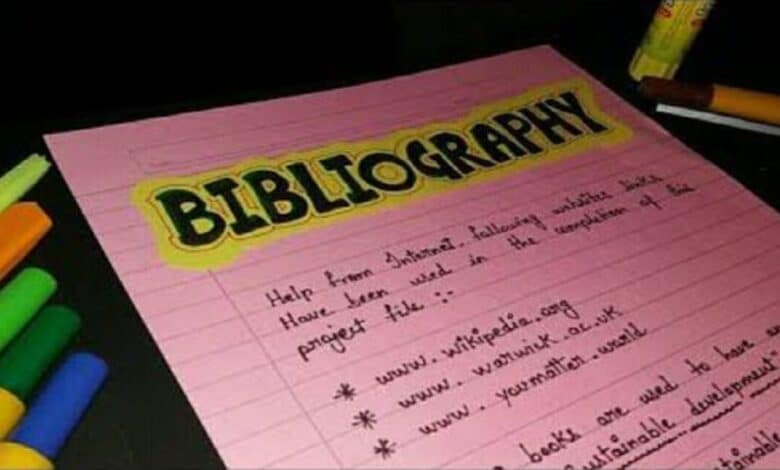Bibliography for school project: Expert Tips!

In the realm of academia, research projects are the building blocks of knowledge. And at the heart of any well-executed research project lies the all-important bibliography. Whether you’re a high school student working on your first major assignment or a seasoned scholar, a well-constructed bibliography is the key to success. It not only adds credibility to your work but also acknowledges the sources that have influenced your research.
In this comprehensive guide, we’ll delve into the art of creating the perfect bibliography for your school project. You’ll learn everything from the basics to advanced tips that will help you ace your research game.
The Fundamentals of Bibliography
Before we dive into the nitty-gritty, let’s start with the basics.
What Is a Bibliography?
At its core, a bibliography is a list of sources you’ve consulted while working on your research project. These sources can include books, articles, websites, interviews, or any other materials relevant to your topic. A bibliography serves two primary purposes:
- Credibility: It showcases the depth of your research, demonstrating that you’ve explored various sources to support your claims.
- Acknowledgment: It pays tribute to the hard work of others by giving them proper credit for their contributions to your project.
The Difference Between Bibliography and Works Cited
Many students often confuse a bibliography with a works cited page. The key distinction is that a bibliography includes all the sources you’ve consulted, while a works cited page lists only the sources you’ve directly cited within your work.
In some cases, your instructor may ask for one or the other, so make sure to follow their specific guidelines.
Building Your Bibliography
Creating a comprehensive bibliography can be a daunting task, but it’s a crucial element of any research project. Let’s break down the process step by step.
Step 1: Choose the Right Sources
The first and foremost step in creating a powerful bibliography is selecting the right sources. Start with these guidelines:
- Relevance: Ensure that the source is directly related to your topic and will provide valuable information for your research.
- Credibility: Opt for sources from reputable authors, publishers, and institutions. Peer-reviewed articles and books from established publishers are often good choices.
- Currency: Depending on your topic, consider the publication date of the source. For recent developments, you’ll want up-to-date materials, while historical research may require older sources.
Step 2: Document Your Sources
Keeping meticulous records of your sources is essential. Here’s what you need to do:
- Record Details: Note down all the essential details of each source, such as the author’s name, title, publication date, page numbers, and the source’s publication or website.
- Use a Citation Style: Depending on your school’s requirements, use a specific citation style like APA, MLA, Chicago, or Harvard. Each style has its guidelines for formatting citations.
Step 3: Organize Your Bibliography
The organization of your bibliography can vary depending on your chosen citation style. However, here are some general tips:
- Alphabetical Order: Typically, sources in your bibliography should be listed in alphabetical order according to the author’s last name.
- Hanging Indents: Use hanging indents to format your citations properly. This means that the first line is flush with the left margin, and subsequent lines are indented.
- Clear Formatting: Ensure that your citations are consistent in terms of formatting, including italics for book titles and quotation marks for article titles.
Step 4: Review and Revise
Don’t rush through this step! Take the time to review and revise your bibliography for accuracy and completeness. Check that all the sources are properly formatted and that you haven’t missed any important references.
Citation Styles Demystified
Now that you understand the importance of accurate citations and the basics of building your bibliography, let’s delve into some of the most commonly used citation styles. Each style has its unique rules and guidelines, so be sure to adhere to the one specified by your school or instructor.
MLA (Modern Language Association) Style
MLA style is frequently used in humanities and liberal arts. When creating your bibliography in MLA style, keep these key points in mind:
- Author’s name: Last name, first name.
- Title of source: Italicize for books, plays, films, and websites. Use quotation marks for articles, chapters, and web pages.
- Publication date: Follow the format of “Day Month Year” (e.g., 12 Oct. 2023).
APA (American Psychological Association) Style
APA style is commonly used in the social sciences. For a bibliography in APA style, adhere to the following rules:
- Author’s name: Last name, first initial.
- Title of source: Italicize only for books, reports, and brochures.
- Publication date: Use the format of “Year, Month Day” (e.g., 2023, October 12).
Chicago Manual of Style
The Chicago style offers two distinct citation formats: Notes and Bibliography (used in history and some humanities fields) and Author-Date (used in the natural and social sciences). Here, we’ll focus on the Notes and Bibliography style, which is similar to the standard bibliography format.
- Author’s name: First name, last name.
- Title of source: Italicize for books, magazines, and newspapers. Use quotation marks for article titles.
- Publication date: Place it in parentheses, followed by a period (e.g., (2023).).
Harvard Referencing Style
Harvard style is widely used in various disciplines. In Harvard referencing, format your bibliography as follows:
- Author’s name: Last name, first initial.
- Title of source: Italicize only for books and reports.
- Publication date: Enclose it in parentheses (e.g., (2023)).
By understanding these commonly used citation styles, you can confidently create a bibliography tailored to your research project’s specific requirements.
Advanced Tips for an Outstanding Bibliography
Now that you’re well-versed in the fundamentals, let’s explore some advanced tips to take your bibliography to the next level.
Use Citation Tools
Save time and ensure accuracy by using citation management tools like Zotero, EndNote, or Mendeley. These tools help you organize your sources, generate citations in various styles, and easily insert them into your documents.
Stay Consistent
Consistency is key when creating a bibliography. Ensure that you adhere to your chosen citation style throughout your entire project. Mixing different styles can lead to confusion and lower the quality of your work.
Annotate Your Sources
Consider adding annotations to your bibliography. Annotations are brief descriptions of each source that summarize its main points and relevance to your research. They can help you quickly reference a source’s content and streamline your research process.
Seek Feedback
Before finalizing your bibliography, ask a peer or instructor to review it. They can provide valuable feedback on the accuracy and organization of your citations.
Keep It Updated
If you find new sources during your research, don’t forget to add them to your bibliography. Staying organized and updating your sources as you progress will save you time in the long run.
Read Communication is a Non-Stop: The Key to Effective Connection
Conclusion
In the world of academia, creating a top-notch bibliography is a skill that can set you apart from the rest. It’s a mark of your dedication to thorough research and your commitment to giving credit where it’s due. As you embark on your next school project, remember that the perfect bibliography is not just a list of sources; it’s a testament to your academic integrity and commitment to the pursuit of knowledge.
By following the fundamental steps of choosing the right sources, documenting them properly, and organizing your bibliography effectively, you’ll be well on your way to crafting a bibliography that not only impresses your instructors but also enhances the overall quality of your research project.
Additionally, familiarizing yourself with the different citation styles and applying advanced tips will make the process smoother and more efficient, ensuring that your bibliography is not just a requirement but an integral part of your research journey.
So, as you embark on your next school project, remember the power of a well-constructed bibliography and the impact it can have on your academic success. With this guide as your trusted companion, you’ll be well-prepared to nail your research and leave an indelible mark on the world of academia. Happy researching!


